8/28/2013
So Good It’s Almost Scary
Chris Beytes, Ellen C. Wells, Jennifer Zurko & Jennifer Polanz
Great!
That single word, including the exclamation point, was the one we heard most often when we’d ask, “So, how’s the show?” While talking to grower George Lucas of Lucas Greenhouses, Monroeville, New Jersey, on another topic, he used the same adjective. So did Norm Belliveau of Summit Plastics. Susan Goodenough of Seederman Seeder said, “Really, really good … almost scary” (which we think means the same as great).
Why? Plenty of traffic (a press release from OFA said there were more than 9,000 attendees), and a “good buzz” on the trade show floor. Seems that spring wasn’t as bad as it could have been for most growers we talked to. George Lucas was down 20% May 1, yet finished the season up almost 6%. June was DOUBLE last year, he added. We heard similar stories from every grower we asked: April was nonexistent, May was fair and June rocked enough (and lasted into early July) to make up the deficit. Admittedly, growers who are down in the dumps don’t often get out to trade shows, so maybe only the choir was in attendance. But the choir was singing a happy song.
During the press luncheon, we were filled in on a few more details of OFA’s plan to expand its offerings for retailers at the 2014 Short Course. The additional 50,000 sq. ft. of dedicated space for the retail channel will be located in Battelle Hall, which is upstairs from the Connector Area of the Convention Center. In fact, the space is the original venue for the Short Course before the Convention Center expanded a number of years ago. Call it a homecoming of sorts for the show.
It won’t be your traditional pipe and drape exhibitor layout, either. Rather, it will be laid out in an island format, with each island being four exhibitor spaces. It’s more of a European style of trade show, apparently. (The current exhibitor hall will remain in the aisle format.) Why the Euro style? According to OFA’s CEO Michael Geary, it’ll help vendors be more innovative in how they display their products, allowing them to set up their wares more like how a retailer would display products to the end consumer.
Again, why is OFA expanding the retail presence at Short Course? As Michael told us, our industry makes great products and it is OFA’s job to help retailers sell more of it. So along with the expanded retail presence on the trade show floor, they’ll also have an expanded educational line up.
Read on to see what we saw and learned while cruising the aisles.
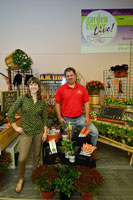 Merchandising Contests
Merchandising Contests
The super-fun and always inspirational Garden Center Live! Merchandising Contest was held at the OFA Short Course for its fifth year. Similar to an episode of The Food Network’s “Iron Chef America,” contestants are given certain plants, hardgoods and structures with which to build displays. Judging is based on the final display’s shoppability, visual appeal, and inspiration and education for the customer.
This year’s competition took a slightly different turn from previous years. Instead of a round-robin competition with one winner, there were instead two separate competitions. The first saw pairs of contestants working together to create a display based on having the tools necessary for gardeners to get their projects done. This contest resulted in Jessica Schaefer and Adam Duncan (pictured) of A & J Landscape in Ohio beating out Emma Stidham and Jeff Wallitsch of Wallitsch Garden Center in Kentucky in a close competition.
The second contest was based on a “PINspired!” theme, or a display that would speak to those wanting to recreate a DIY project spotted on a social media site. Joe Lutey of Wojo’s Greenhouse in Michigan bested Richard Gibson of Soleil Garden Center in Tennessee.
Proven Winners’ New Annual Combo
The home gardeners have voted and the new name for Proven Winners national combo for 2014 is Strawberry Kiss, which will be the main focus of their advertising campaign in consumer magazines. The three varieties that make up Strawberry Kiss are Superbells Pink Calibrachoa, Supertunia Mini Appleblossom Petunia and the new Superbena Royale Whitecap Verbena.
Anthony Tesselaar
The marketer of Flower Carpet rose (over 100 million sold, they say!) is following up a new “decorator rose” called Sweet Spot, named for the bright eye on each single flower. The new series starts with four colors, but they’ve got 24 experimentals that could be introduced and more than 160 others under evaluation. While other eye-type roses don’t like humidity and only perform well in dry climates, Tesselaar says Sweet Spot has been tested at 22 trial sites, including in Florida. They’ve been “ruthless” in their evaluation, says Tesselaar’s Phillip Townsend (pictured, with Sweet Spot Calypso). And while not quite as tough or disease-resistant as Flower Carpet, its wide color range should make Sweet Spot more suitable for decorating in the landscape. Plants will be at retail in Spring 2014.
Heucherella for the Heat
Ornamental grass experts Emerald Coast Growers showed us a series of heucherellas for the south, as John Friel put it. In the shade, all four colors of the Southern collection are heat and humidity tolerant. The four varieties are: Gunsmoke, Solar Eclipse, Sunrise Falls and Sweet Tea.
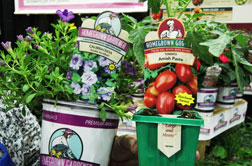 Homegrown Gardener
Homegrown Gardener
Schmidt Bros Inc. of Swanton, Ohio, has long sold their Homegrown Gourmet line of herbs and veggies. Now they’re launching a sister flower brand. Homegrown Gardener will feature “premium annuals at value prices,” says Kathy Judge, including both seed and vegetative items. The line is available for other growers to pick up if they’d like their own branded products. Homegrown Gourmet and Homegrown Gardener are exclusive to IGCs.
Improved Seeding
Always looking for incremental improvements, seeder manufacturers have brought out some subtle, but interesting features. (For some reason, marigolds seemed to be a theme this year.)
Blackmore Company. Blackmore added a second air curtain to their cylinder seeder and tweaked their placement to improve how the machine singulates and sows marigold seeds. David Steiner says growers should get 97% to 98% correct single sows at 300-plus trays per hour with marigolds. They also tweaked the dibbler to help push seeds into the proper cells and tweaked the plumbing on their seed recovery system to make seed changes quicker. After all, David says, the key to sowing seed fast isn’t fast sowing, but fast changes between varieties. Customers can get kits for upgrading their air curtain and seed recovery systems.
Visser. Visser has added a special tip to their drum seeder to handle marigold seeds; it works with other hard-to-handle seeds, too, with an adjustment of the vacuum. They claim 99% correct seed placement with their unit.
AgriNomix
The company with the big red machines also offers a Raised Drum Kit for their Beta and Zeta drum seeder that, like Visser’s, improves singulation and sowing of marigolds, dahlias and other difficult seeds.
Also in the AgriNomix booth, we saw some of the newest digital technology being offered as options on their transplanters. “Production Assurance” uses an Internet connection within the machine to link to the AgriNomix headquarters in Ohio. If the machine’s computer senses a fault or problem (like the “check engine” light in your car), it will send an email notification to AgriNomix, where technicians can determine if it’s a minor or major issue. A webcam mounted inside the transplanter allows technicians to watch the machine in action to further diagnose any issues. The technicians can even take over “virtual control” of the machine by accessing the control panel remotely. All this can reduce downtime and allow greenhouse staff to focus on growing, not machine repairs, says Robert Lando.
AgriNomix can also incorporation iPads into some machines to provide real-time output data for operators, such as goal and output per hour, run time and even down time.
Environmental Control for the Masses
HortiMax Growing Solutions has been a player in the North American environmental controls market for large growers for 30 years, but at Short Course it unveiled its new CX500 system, which is far more adaptable for smaller operations. “What we are aiming for is that integration of control,” explains Joep van den Bosch, CEO of HortiMax. The new adaptive technology can grow with the operation, from controlling as little as two zones to as much as 50 zones with multiple boilers, irrigation systems and more. It comes with an easy-to-use graphical user interface and phone apps for monitoring and controlling greenhouse conditions. Also, HortiMax has set up an office in Leamington, Ontario, that’s centrally located to serve the North American market.
Dramm Corporation
A hose reel seems pretty simple, but Dramm’s new Remote Wind Reel offers an unexpected feature; namely, you communicate with the reel via a quick pull of the spray trigger. You can signal it to reel in the hose as you spray, eliminating tangles. And, of course, it has manual override. The reel holds up to 350 ft. of hose. It comes on their 100-gal. sprayer only.
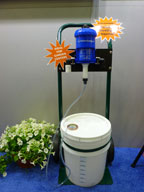 Portable Feeding
Portable Feeding
Dosatron went a little further with their Li’l Bud-D and created a more inexpensive, even more portable version especially for garden centers. The Eco-Cart takes an injector and makes it mobile by providing quick and easy dispensing for spot treating in the retail area. It’s also a great value because the Eco-Cart includes the cart (which can be ordered separately, too), a 5-gal. bucket with a lid, a Dosatron fertilizer injector (accommodates 7, 11 and 14 GPM ones) and plumbing. Great for fertilizers, fungicides, pesticides and disinfectants.
Bouldin & Lawson
Easy to spot the new and improved machines in the B&L booth, as they all feature a fresh two-tone green and tan paint scheme. For instance, their Mini Flat Filler now accommodates shuttle trays and hanging baskets. Their mid-sized machines have bigger openings to allow containers up to 18 in. by 16 in. And their EP 2200 filler (pictured) now features a servo motor drill that will accurately dibble baskets and shuttle trays at a speed of up to 2,000 per hour.
Also new at B&L is a Coir (coconut fiber) Processor. Coir bricks are compressed at a 5:1 to 7:1 ratio. They’re cheap, but hard to handle. B&L’s new Coir Processor shreds, fluffs and hydrates coir at a rate of 30 yards per hour. They say there’s been considerable international interest in the machine, due to the ever-widening acceptance and use of coir as a substrate.
GreenWay Plant Shipper
Designed by grower Andy Kreiger of Krieger Greenhouses in Jefferson, Iowa, it was his solution to the challenge of needing to ship product further, while not burdening his customers with unwanted metal shipping racks. Not to mention his own problems with retrieval. The result is the GreenWay Plant Shipper, designed specifically for bedding plants. Andy uses it himself, shipping 80% of his 11 acres of product on them via FedEx freight or other LTL carriers. Sized for flats, the GreenWay is 45 in. by 45 in. square and full or half height … up to 12 shelves. Cost ranges from $41 to $68, he says; about half that of cardboard boxes. “With this, I can be a grower instead of a transportation company,” he says.
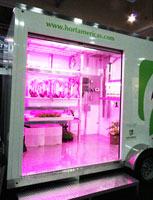 Hort Americas
Hort Americas
In European trade shows, high-tech LED lighting is the order of the day. But it’s still new here. Hort Americas was introducing U.S. growers to the concept through a unique trailer-mounted mini-version of a Green POD Controlled Plant Growth Environment. Developed by G-Con Manufacturing of Texas, the Green POD is a self-contained growing environment featuring LEDs, benches, fertigation, HVAC and humidity control for any sort of growing, from research to tissue culture to vertical farming
trials.
Cherry Creek Systems
Chris Lundgren shows off Cherry Creek’s new Pace Setter conveyer, which he says sets the pace for portable conveyor belts by being battery powered, making it a “go-anywhere, do-anything” conveyor system. The deep-cycle 24-volt batteries are rechargeable and run for up to 20 hours. Variable speed adjusts from 10 to 35 ft. per minute. Available in 10-, 20- and 30-ft. lengths, with prices between $2,500 and $3,500.
Harvest Automation
The hit of the show might have been Harvey, the Harvest Automation robot, which was following Rebekah Lando and her sister, Rachel, around the trade show floor like a loveable puppy. Cute, yes, but the HV-100 is a serious tool that can space 200 3-gal. pots per hour with little human involvement. Designed by a team of scientific geniuses near Boston, Harvey uses 20 sensors (but no GPS) and some very sophisticated MIT “behavior-based programming” to keep track of what it’s doing and what’s going on around it. Harvey’s battery lasts four to five hours. He costs $30,000, and several nurseries, including Willoway Nursery in Ohio, Altman Plants in California and Loma Vista Nursery in Kansas, have already bought some.
S.B. Machinerie
We love all-in-one machines for the small grower—when they work. And this one looks good. It’s the SB 05 Manual Mixer, Bale Breaker, Flat Filler and Pot Filler. It’s designed to break compressed peat bales, mix soil and fill your various flats and pots. It holds 0.7 yards of media. You feed trays in manually from the left or right; an optional power conveyer can help automate that process. At just $5,300 (show special pricing), even the smallest grower can get efficient! Ball Seed is the U.S. distributor.
Conic System
In the TTA booth, Miquel Ribera of Conic System of Spain was showing a machine for grafting tomatoes and other vegetable plants. The unit is the third generation of this technology; Miquel claims 400 to 500 grafts per hour by a good operator versus 100 to 200 per hour when done by hand. Cost is $30,000.
More Cool Stuff
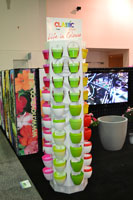 A Colorful Life via A-ROO
A Colorful Life via A-ROO
This company never disappoints at Short Course, and this year it displayed some very unique, 2-color gradient injection mold plastic pots that looked very much like ceramic. A-ROO is the U.S. distributor of the Italian-made Dante line, as well as the Life In Colour line of deco cover pots. The pots are available in a variety of sizes and can be purchased in case packs for retail or in bulk packs for growers looking to increase the value of their potted plants. The displays can be purchased, as well.
Building a Better Pot
SlitPots are a new introduction in the United States from Kaneya Co., Ltd. It’s a technology created after cyclamen growers in Japan lamented losses of up to 30% because plants couldn’t withstand 90-plus degree days in the summer. They asked the Kaneya Co., the leading Japanese plastic pot manufacturer, to create a pot that would help plants survive the heat. The company worked for five years to create the SlitPot, which has vents on the bottom to enhance drainage and aeration, thereby reducing the stress on plants and encouraging healthy root growth. The plants have proven to reduce losses during production and post-production, as well as reduce fertilizer and chemical use and improve shelf life. Kazuta Aoyama, an international sales representative for Kaneya who was at Short Course, says he would welcome any trials on the pots by growers or universities. Anyone interested in trialing the pots can email him at
kazuta.aoyama@gmail.com.
McConkey’s Custom Containers
Have you had an idea for a special pot or container? Now you can turn it into reality by contacting McConkey. They have a new program that allows them to partner with growers to develop a custom-blueprint for any pot or container. McConkey’s designers will work up a drawing, make a prototype, and if it works, the grower will have a finished product.
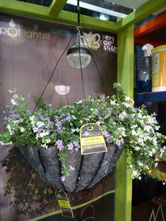 Spotlight on Lighting
Spotlight on Lighting
A new line of Spotlights! solar lights for baskets, containers and landscapes. One model can be attached to the supports of a hanging basket to illuminate the flowers below and the stick version can be inserted into pots, beds, or along walkways. It’s their hottest-selling category, they say.
Beautiful (and Functional) Benching
A new line of benches from the Italian company Orlandelli Group (distributed in the U.S. by VRE Systems) are based on the ebb and flood concept of watering plants, keeping the water in the benches and not on the ground for an elegant garden center display. The benches come in a wide variety of sizes and styles, from hexagonal tables to benches and tiered carts. The line is made in Europe of aluminum and non-toxic PVC and can be ordered with different options, like either stationary or on casters and with or without telescopic legs for a modular and flexible design. The idea for the benches came out of the need for a better display at Italy’s largest garden center, Valle dei Fiori, which spurred the creation of the Orlandelli Group. “We are a group of companies, and we are the technical part to produce elements to solve daily challenges in the garden center,” says Raffaele Cantoni, area manager for the American market. The model kit frame is pictured with the optional canopy.
Natural Color
The Robert Allen Home & Garden booth was alive with color—right down to the round, pre-formed coir fiber basket liners. The liners come in 12-in., 14-in. and 16-in. in red, purple, green, brown and natural. They also had wire hanging baskets in a multitude of colors, including cherry, mango, lemon, grape, apple and white. But what really caught the eye was a display of new plastic pot covers in three display options. The Be Everyday Chic line features a wide variety of colors that are available in each of the three display types. The company showed off its colorful plastic trellises, too, which came in two options: a vining one and a cage trellis (the cage trellis is pictured here with CEO Ken Kooistra).
The Benefit of Beneficial Organisms
Better soil makes a better plant, right? That’s the method behind TeraGanix, a liquid microbial inoculant that contains 30 different kinds of beneficial organisms. “It improves nutrient uptake and brings the biology into the environment to make it happen,” says Patrick Smyth, CEO of TeraGanix, who adds he received quite a lot of interest in his product from larger growers during Short Course. “It promotes less pesticide and fungicide use and creates an extensive root system for a much healthier product.”
The inoculant also acts as an anti-corrosive device as it’s administered through the irrigation system or tank mix, eating away bacteria in the lines and keeping the system clean. The product is more stable than compost tea, too, so it can be shipped and kept longer. It’s available in bottles for retail or larger quantities for growers. Patrick says the company has worked with the University of California—Davis, too, on a number of studies with the product.
Tired of terra cotta?
Consumers searching for a natural-looking decorative container will be pleased with Braun’s new Portofino collection of planters. Lightweight, but durable, there are a multitude of sizes and designs in slate, sandstone and natural colors that work for any type of planting arrangement indoors and out.
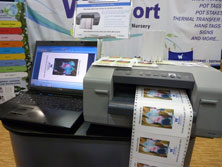 Color Tags on the Fly
Color Tags on the Fly
West Hort was demonstrating the only color printer for waterproof and tear- and fade-resistant labels and tags. The Epson ColorWorks C831 Printer costs 75% less to operate than an HP printer and helps supplement those small print runs beyond your orders from the tag companies. West Hort’s Dave Long said that most large and medium-sized growing operations have a labeling program for their computers, but there are plans in the works to provide a software template for smaller growers who don’t have one. Dave said harder stock tags and thick pot stakes will also be available soon.
You can select a print resolution up to 720 dpi and adjust the printer to handle widths from 1.2 in to 9.5 in. And it’s fast—prints 3.7 in. per second. Also works for in-house retail signage and small POP. It costs approximately $2,000 for the printer, which comes with a 1-year warranty.
GT